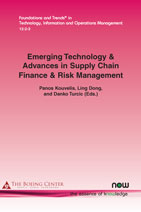Blockchain and other Distributed Ledger Technologies in Operations
By Volodymyr Babich, Georgetown University, USA, vob2@georgetown.edu | Gilles Hilary, Georgetown University, USA, Gilles.Hilary@georgetown.edu
Abstract
Blockchain is a form of distributed ledger technology (DLT) that has grown in prominence, although its full potential and possible downsides are not yet fully understood, especially with respect to Operations Management (OM). This manuscript contributes to filling in this gap. We identify three research themes in applying Blockchain technology to OM, illustrated through several applications to OM problems. Elsewhere, in a companion article (Babich and Hilary, 2018), we provide a conceptual framework for the role of Blockchain and other DLT in OM, along with specific examples of research questions, and we demonstrate how research in economics can inform research in OM on Blockchain applications. Finally, we discuss possible future uses for the technology.
Emerging Technology & Advances in Supply Chain Finance & Risk Management
Emerging Technology & Advances in Supply Chain Finance & Risk Management reflects the state-of-the-art in research thought leadership in supply chain finance and risk management, and it contains great expository pieces on how advanced technologies are shaping supply chains and risk management within them. You will also find ideas on how supply chain finance and risk management can be best taught in our classrooms.
The volume is divided into three parts, each part reflecting a major active research area of the field including: Part 1: Supply Chain Finance; Part 2: Financial Hedging and Commodity Risks; Part 3: Operational Strategies and Risk Management.
Part 1 deals with the broad area of supply chain finance and programs that will better allow for working capital management within supply chains. Part 2 introduces concepts of hedging financial and operational risks due to uncertain commodity prices, fluctuating exchange rates, and volatile interest rates. Emphasis is placed on understanding how financial hedges can be used for hedging relevant supply chain risks in a way that reflects modern view of financial risk management. Part 3 examines topics and solution approaches reflecting the more traditional treatments in the contemporary literature of operational and supply chain risks. This volume provides rich implications for future research directions in efforts to master the new complexities and uncertainties of the global business environment and better understand the impact of advanced technologies in global supply chains.

Companion
Foundations and Trends® in Technology, Information and Operations Management, Volume 12, Issue 2-3 Special Issue: Emerging Technology & Advances in Supply Chain Finance & Risk Management
See the other articles that are also part of this special issue.